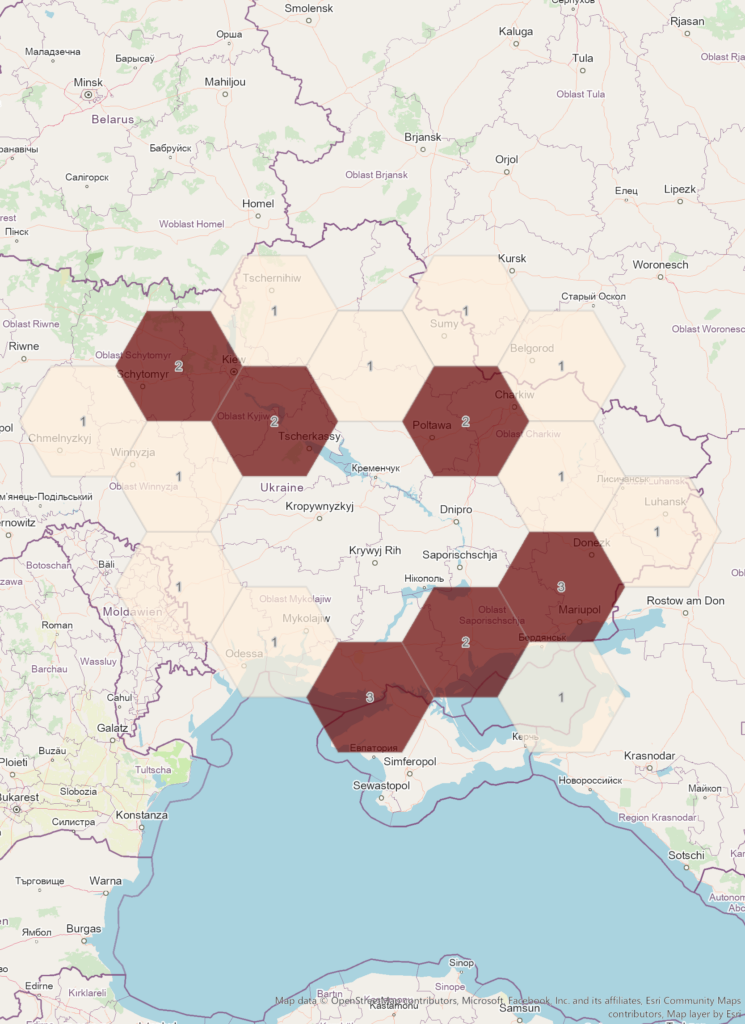conflicts module
Query armed conflict events worldwide and visualize them using spatial aggregations. This service aggregates, clusters, and filters thousands of armed conflict events using the raw UCDP Candidate Events Dataset as the ground truth.
Please cite:
Hegre, Håvard, Mihai Croicu, Kristine Eck, and Stina Högbladh (July 2020) Introducing the UCDP Candidate Events Dataset. Research & Politics
We are using a web mercator projection using a grid size being optimized for geographic visualization. Each grid cell has a count attribute representing the number of armed conflict events of the corresponding grid cell. This API aggregates locations where some armed conflict took place using geospatial intelligence operations. The geospatial results support the GeoJSON and Esri Features format out of the box.

Aggregated armed conflict events of 24th February 2022
For example:
>>> from georapid.client import GeoRapidClient
>>> from georapid.factory import EnvironmentClientFactory
>>> from georapid.conflicts import aggregate
>>> from georapid.formats import OutFormat
>>> host = "geoconflicts.p.rapidapi.com"
>>> client: GeoRapidClient = EnvironmentClientFactory.create_client_with_host(host)
>>> features_dict = aggregate(client, format=OutFormat.ESRI)
- georapid.conflicts.aggregate(client: GeoRapidClient, date: datetime = datetime.datetime(2022, 2, 24, 0, 0), format=OutFormat.GEOJSON)
Aggregates the armed conflict events using a spatial grid and returns the features as hexagonal bins. You must define a specific date intersecting the valid date extent. The underlying event database collects data since 2020-01-01. The format can be GeoJSON or Esri JSON.
- georapid.conflicts.cluster(client: GeoRapidClient, date: datetime = datetime.datetime(2022, 2, 24, 0, 0), format=OutFormat.GEOJSON)
Creates spatial clusters using the armed conflict events and returns the features as cluster polygons. You must define a specific date intersecting the valid date extent. The underlying event database collects data since 2020-01-01. The format can be GeoJSON or Esri JSON.
- georapid.conflicts.count(client: GeoRapidClient)
Returns the number of armed conflict events as a JSON result.
- georapid.conflicts.date_extent(client: GeoRapidClient)
Returns the valid date extent (start and end date) of the armed conflict events as a JSON result.
- georapid.conflicts.extent(client: GeoRapidClient)
Returns the valid spatial extent (xmin, ymin, xmax, ymax) of the armed conflict events as a JSON result.
- georapid.conflicts.query(client: GeoRapidClient, date: datetime = datetime.datetime(2022, 2, 24, 0, 0), format=OutFormat.GEOJSON)
Queries the armed conflict events and returns the events as features. You must define a specific date intersecting the valid date extent. The underlying event database collects data since 2020-01-01. The format can be GeoJSON or Esri JSON.